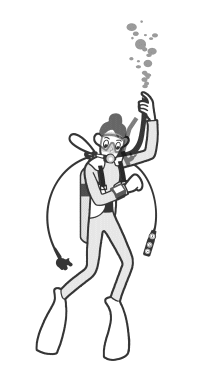 Multi-Level Diving Multi-Level Diving
When diving, there is a method for calculating for the constantly changing conditions, including water depth and no-decompression times - we use a dive computer.
|
|
【Dive Computers】
Dive tables generally calculate a dive profile’s no-decompression limits in which the diver goes down to the planned maximum depth for a certain period and then ascends. However, most dives vary from that to some degree.
A dive computer uses real-time calculations to take into account changes in depth when displaying remaining no-decompression time.
As well, they flash or beep alarm if your rate of ascent is too fast.
Once back above water, your dive profile and time until safe to fly are also displayed.
The information your dive computer will display is indispensible for logging your dives in your log book. |

Carefully use your dive computer when ascending. |
|
|
【Dive Computer Terms】
|
|
|
|
■Ceiling Depth
If, by chance, you should need to make a decompression stop, this is the most efficient and maximum shallow depth. It is at the prescribed time and depth that the diver must maintain the decompression stop. |
 |
|
|
■Scroll
During your surface interval, the computer will calculate and display real-time estimations for non-decompression times and depths for a repetitive dive.
|
 |
|
|
■Time Until Safe To Fly
Once at surface interval setting, this indicator on a dive computer displays the remaining time until you can safely fly. (Generally, 24 hours is considered safe, and 12-18 hours the absolute minimum.) |
 |
|
|

